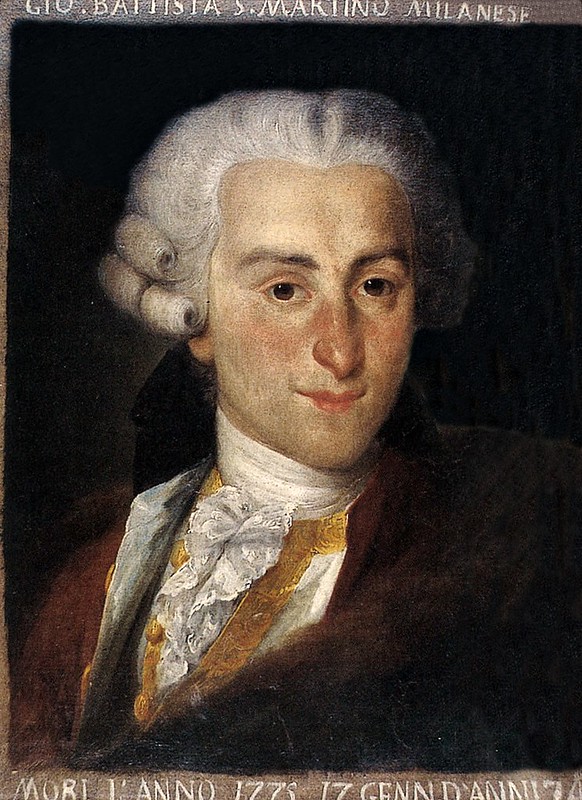Giovanni Battista Sammartini (c.1700-1775)
- Beatus Vir (in Re maggiore) a 4 [JC 104]
Performers: Solists and Choir Radiotelevisione svizzera; I Barocchіstі; Dіego Fasolіs (conductor)
Painting: Domenico Riccardi 'Dondino' (fl. c.1750-c.1800) - Giovanni Battista Sammartini (c.1700-1775)
Further info: Giovanni Battista Sammartini (c.1700-1775) - Magnificat
---
Italian composer, brother of Giuseppe Sammartini (1695-1750). He was the
seventh of eight children of Alexis Saint-Martin, a French oboist who
emigrated to Italy, and Girolama de Federici. He was probably born in
Milan, the city in which he lived all his life. Since in his death
certificate he is said to have been 74, he was presumably born in 1700
or 1701. His earliest musical instruction probably came from his father.
In 1717 Giuseppe and G.B. Sammartini were listed as oboists at S Celso,
Milan, and in 1720 the ‘Sammartini brothers’ were listed as oboists in
the orchestra of the Regio Ducal Teatro there. He became maestro di
cappella of the Congregazione del SS Entierro in 1728 and continued in
that post for most of his life; his last Lenten cantatas are dated 1773.
By 1726 he was called ‘very famous’ in his contract as substitute
maestro di cappella of S Ambrogio. Also in 1726 he composed a Christmas
oratorio for S Fedele entitled Gesù bambino adorato dalli pastori. J.J.
Quantz, who visited Milan that year, wrote grudgingly of the music of
Sammartini and Francesco Fiorino as ‘not bad’, though he noted that they
were the leading church composers of the city. In his maturity he
became the most active church composer in Milan. The almanac Milano
sacro for 1761-75 lists him as the maestro di cappella of eight
churches; these included the ducal chapel S Gottardo, whose director he
became in 1768. An excellent organist, he was praised by Burney as
having ‘a way peculiar to himself of touching that instrument, which is
truly masterly and pleasing’. The 1730s saw a notable stream of
symphonies, concertos, sonatas and dramatic works from Sammartini's pen,
and recognition of his music outside Italy. His first opera, 'Memet',
was performed in Lodi in 1732, and possibly in Vienna the same year. By
the early 1730s he had become the leading figure in the earliest
symphonic school in Europe, which included such composers from Milan and
nearby as Brioschi, Galimberti, Giulini, Lampugnani and Chiesa.
From 1733 there are records of Sammartini's acting as judge in
competitions for positions at the cathedral and other churches; in 1762
he sat on one such jury with Padre Martini. Apart from his teaching at
the Collegio de'Nobili, where he was appointed in 1730, only two of his
no doubt numerous pupils can be identified with any certainty: Count
Giorgio Giulini (1716-1780), a popular Milanese dilettante composer of
symphonies, and Christoph Willibald Gluck, who probably studied with
Sammartini from 1737 to 1741. As Milan's most famous composer, he took a
leading role in the life of the city, composing and conducting music
for religious and state occasions. In 1757 and 1759 he took part in
feste solenne at S Celso. In 1758 he became one of the founders of a
philharmonic society in Milan, reflecting the city's keen interest in
orchestral music. From 1750 he sent mainly orchestral and chamber works
to the Margrave Carl Friedrich of Baden-Durlach in Karlsruhe. In 1760 he
published a collection of six of his finest string trios, dedicating
the print to Don Filippo, Duke of Parma (1721-65), one of his most
important patrons. During the 1750s and 60s he came into contact with
some of the leading composers of the younger generation, notably J.C.
Bach, who lived in Milan from about 1755 to 1762, and Luigi Boccherini.
Sammartini is mentioned in Leopold Mozart's letters from Milan in 1770:
he heard Wolfgang perform and warmly supported him when there were
intrigues against his opera Mitridate, rè di Ponto. Leopold described
Sammartini as a person ‘whom everyone trusts’. During 1770 he also met
Charles Burney, who visited Milan in July and left a valuable
description of musical life in the city and performances of Sammartini's
music. Between April and September 1773 he composed six string
quintets, his last extant dated works. That Sammartini’s death in
January 1775 was unexpected is shown by the schedule of 24 performances
in Milanese churches planned for 1775. Of Sammartini's family, all that
is known is that he was married twice, first to Margherita Benna
(1727-1754) and then (on 23 June 1755) to Rosalinda Acquanio, and that
his daughter, Marianna Rosa (1733-?), was a singer.

Cap comentari:
Publica un comentari a l'entrada